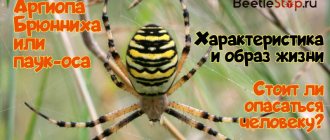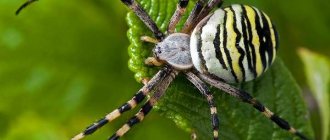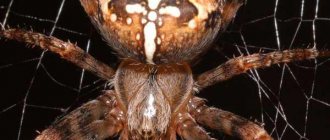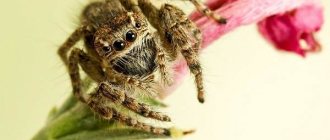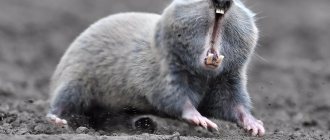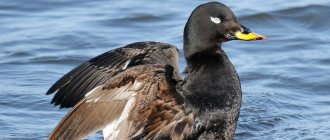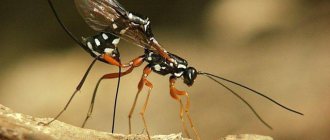The Argiope bruennichi or wasp spider is a common spider that stands out for its bright colors. Arthropods differ from other spiders in their way of life. Such factors have led to the fact that this animal is increasingly kept as an exotic pet.
The spider received this name in honor of the Danish zoologist Morten Trane Brünnich.
Spider wasp or Agryope Brunnich, appearance
Description and features
To describe the appearance of Argiope, we need a number of special “spider” terms.
1. First, let's introduce you to the concept of chelicerae. If translated from ancient Greek, you get two words - claw and horn. This is the first pair of limbs, or jaws, of arachnids and other arthropods. They are located in front of and above the mouth.
They usually look like claws and consist of several segments. At the tip of such claws there are ducts of poisonous glands. Now we can explain who araneomorphic spiders are - their chelicerae are located towards each other, and they fold together, sometimes overlapping one another. Such chelicerae are designed to attack large prey, sometimes larger than the hunter himself.
2. The second important term in the description of spiders is pedipalps. Translated from ancient Greek, we get two words again - leg and feel. This is the second pair of limbs, the pedicles, located on the cephalothorax (called the prosoma in chelicerates). They are located on the side of the chelicerae, and behind them there is a second pair of walking legs.
“Dismembered” into several segments, like phalanges. Adult male spiders use every last segment of the pedipalp at the moment of copulation with the female. They are transformed into a kind of sexual organ called the cymbium. It is used as a reservoir for sperm, as well as for directly introducing it into the female's genital openings.
3. And the last complex concept is stabilimentum (or stabiliment). This is a prominent thickening on the web. Usually made in the form of a zigzag weave of numerous threads at the center. There can be one, two, three or more such pronounced thickenings, depending on the type of spider.
It can be vertical in the form of a line, it can go in a circle, or it can be in the shape of a cross. Moreover, this cross is made in the form of the letter X. A very important thing for spiders, as you can see, since they constantly make it on their web. Its exact purpose has not yet been studied by people, despite numerous attempts.
Argiope weaves very strong webs that can trap medium-sized grasshoppers
Perhaps it attracts the attention of the victim, or, conversely, scares away enemies, or disguises a spider in its background. There are so many versions! The version about attracting victims is closest to the truth, especially since the purpose of the web itself is a trap. By the way, it is the stabilimentum that is best visible in ultraviolet rays, which many insects “see”.
Some spiders initially had a linear shape of the stabilimentum, but over time it became cruciform, which also speaks in favor of the version of luring prey. As they say, they do any “tuning” to achieve the desired goal.
Externally, spiders look like this:
The abdomen is entirely covered with transverse stripes of lemon and black color, with light gray stripes between them. Closer to the cephalothorax, the color completely becomes pearl gray or brown. The prosoma itself is entirely covered with a velvety-silver undercoat.
The head is black and there are four pairs of eyes on it, different in size: 2 pairs of small eyes at the bottom, 1 medium pair of large eyes looking straight ahead and 1 pair of eyes, medium in size, on the sides of the head. It also has eight paws, arranged in pairs, the first and second being the longest. The third is the shortest, and the fourth is average.
Due to its bright coloring, Argiope is called the wasp spider or tiger spider.
The size of Argiope is not the largest among spiders, but nevertheless noticeable. The females are large, body length up to 3 cm. And with the length of the legs they reach 5-6 cm. The chelicerae are small. The shape of the body is closer to an oval, the length is twice the width. There are spider warts on the abdomen. These are the organs that form the arachnoid web. This was a female Argiope that was described.
“Men” are several times smaller than “ladies”; they grow up to 0.5 cm. They look inconspicuous and, in the literal sense, gray - they are most often mouse-colored or black, without any stripes. The cephalothorax is usually without hairs, the chelicerae are even smaller than in females.
The family of orb-weaving spiders (Araneidae), which includes Argiopes, is characterized by the production of a large circular network - a catcher's web. The main radial threads are thicker; a thread running in a spiral is attached to them.
The space between us is filled with rosettes in a zigzag pattern. Argiope's web is vertical or at a slight angle to the vertical axis. This arrangement is not accidental; spiders are excellent catchers, and they know how difficult it is to get out of a vertical trap.
Bitten by a spider - what to do before the ambulance arrives
These representatives of the order of arthropods can attack adults and children, both in the house and in open areas.
The bites of many spiders will not cause any significant harm to a person - slight redness on the skin will disappear within a day. But after an attack by a karakurt or hermit, a severe allergic reaction, swelling of the larynx and respiratory arrest can develop. It depends on the type of arthropod what to do if bitten by a spider, what first aid to provide to a person.
Even if there are no symptoms, the victim should be quickly taken to the nearest hospital facility.
Spiders attack humans not only in open areas, but also in residential areas
The effect of poison on the human body
The damage caused to human health depends on the qualitative and quantitative characteristics of the poison released by spiders during bites. The larger the specimen, the greater the danger it poses to humans.
Small arthropods are often simply not able to bite through the skin or produce the amount of poison that can harm an adult or baby. But such a statement is true only for representatives of one species. Tarantulas are larger than karakurts, but their bites do not cause significant harm to humans.
But after an attack by a recluse spider, a fatal outcome is quite possible. Depending on the effect of toxic compounds, scientists distinguish two types of poison:
- neurotoxic, affecting the central and peripheral nervous system;
- hemolytic, destroying red blood cells after penetration into the bloodstream.
Karakurt and brown recluse spiders are the most dangerous arthropod species living in our country. And tourists and experienced travelers can become victims of attacks by other arthropods in any corner of the planet.
Symptoms
The bites of many, even extremely dangerous spiders, are completely painless. A person mistakes a slight swelling or redness on the skin for a scratch and does not take any action.
And the symptoms of general intoxication of the body that developed within a few hours are very similar to the signs of any bacterial or viral infection.
Such a clinical picture of jointed bites can mislead not only the victim, but also diagnosticians.
: Almost all spiders are predators. Having lured the victim with a shiny web, they injected it with a paralyzing poison. And when attacking a person, spiders use this method only to protect their own life.
There are several indirect signs that help a person distinguish a scratch or small wound from a spider bite. After an arthropod attack, the following symptoms occur:
- the bite area gradually swells, and in some cases a pink or red erythema similar to a thin ring forms;
- after a few minutes or hours, pain occurs in the limbs, tremors or convulsions may occur;
- swelling of various localizations develops: at the site of the bite, the upper half of the body or the face;
- heart rate increases, lack of air is felt;
- Blood pressure may rise and then drop to life-threatening levels.
If the victim is predisposed to developing allergic reactions, then large or small red spots form on the skin. They are very itchy and quickly spread throughout the body. Such symptoms of a spider bite can vary significantly depending on the species of the spider.
After a spider bite, the skin turns red and begins to swell quickly
Recluse spider bite
Despite the fact that this type of arthropod is not large in size, its bite is deadly even for a strong, healthy man. The recluse spider pierces the skin in such a way that a person does not experience the slightest discomfort. The poison enters the systemic bloodstream and gradually spreads throughout the body. What does a spider bite look like:
- the bite site swells;
- the size of the swelling rapidly increases;
- large ulcers form.
If this area of skin is not treated with antiseptic agents, then after a while the soft tissues begin to ulcerate and die. The clinical picture of intoxication is similar to signs of a respiratory infection:
- aches in bones and joints;
- rise in temperature;
- decreased functional activity of the cardiovascular system.
The victim's urinary organs are disrupted and their metabolism slows down significantly. The heart rate decreases and difficulty breathing occurs. If a person is not given medical assistance at this stage of intoxication, he may die.
Kinds
The Argiope spider is a genus of araneomorphic spiders from the family Araneidae. There are about 85 species and 3 subspecies in the genus. More than half of the varieties (44) are observed in the south and east of Asia, as well as on the adjacent islands of Oceania. 15 species live in Australia, 8 in America, 11 in Africa and its adjacent islands. Europe boasts only three species: Argiope trifasciata, Argiope bruennichi, Argiope lobata.
- Argiope trifasciata is perhaps the most common species on the planet. It was first described by Per Forsskol in 1775. In Europe, it is observed on the Perinean Peninsula, the Canary Islands and the island of Madeira. The greatest activity is in September-October, when the summer heat subsides.
- Argiope bruennichi ( Argiope Bruennichi ) The name was given in honor of the Danish zoologist and mineralogist Morten Trane Bruennichi (1737-1827), who discovered it. By the appearance of this spider one can make a description of the entire genus of Argiope. The dorsal pattern of the abdomen in the form of black and yellow stripes has led to it being called the argiope wasp spider . In addition, it is also called the zebra spider and the tiger spider.
Sometimes it is also called Argiope three-striped , based on the number of yellow stripes on the body. And of course, we are talking about females; we already know that men do not have such brightness. A characteristic feature is that it spreads with the help of its own web, flying on it on air currents. Therefore, it can be found not only in the southern regions, but sometimes much further north than usual. As they say, whichever way the wind blows.
More often it inhabits desert dry places and steppes. If we clarify the geographical location of populations, we can list;
- Europe (southern and central);
- North Africa;
- Caucasus;
- Crimea;
- Kazakhstan;
- Central and Asia Minor;
- China;
- Korea;
- India;
- Japan.
- In Russia, the northern border passes beyond 55ºN. Most often found in the Central and Central Black Earth regions.
Perhaps due to general climate warming, this spider is moving further north. He is comfortable in meadows and roadsides, forest edges; he chooses sunny and open places. Does not like moisture, prefers dry areas. Settles on shrubs and herbaceous plants. The wasp spider has two stabilimentum in its web; they are located linearly opposite each other, like radii from the center of the web.
Argiope spider is small, maximum size is about 7 cm.
- Argiope lobata ( Argiope lobata ) reaches a size of up to 1.5 cm in females. The abdomen is white and silvery with six deep indentations-lobules, the color of which varies from dark brown to orange. Due to this, it is also called argiope lobata . The web is in the shape of a wheel, the center is densely woven with threads. On the territory of the former Soviet Union, it lives in the Crimea and the Caucasus, in Central Asia and Kazakhstan and, of course, in the European part. Also found in Algeria (northern Africa).
- I would like to highlight one more species in this genus – Argiope ocular. Outwardly, he does not look like his relatives. Its abdomen is red, without yellow-black stripes, and its legs are also red. On the legs, the last two segments are black, with one white segment in front of them.
All covered with hairs, on the cephalothorax they are silvery. Lives in Japan, Taiwan, mainland China. This species, in addition to external characteristics that are uncharacteristic of the genus, is distinguished by one more quality. They often have males that survive without both segments of the pedipalps. In other words, after the second intercourse. And this is a huge rarity in the world of spiders. We'll tell you why a little later.
Where does Argiope Brünnich live?
Photo: Poisonous spider Argiope Brünnich
The habitat of this type of arachnid is quite wide. We can say with confidence that insects live in various parts of the world. Geographical regions of arthropod habitat:
- Africa;
- Europe;
- Asia Minor;
- Middle Asia;
- Japan;
- Kazakhstan;
- Eastern region of Ukraine;
- Indonesia;
- China;
- Russia (Bryansk, Lipetsk, Penza, Tula, Moscow, Oryol, Voronezh, Ulyanovsk, Tambov, and other regions).
In the 60s and 70s, most individuals of Argiope Bryukhin were concentrated within 52-53 degrees north latitude. However, already in the 2000s, information began to arrive about the discovery of the insect in a variety of regions, and, in most cases, the discovered individuals lived much further to the north of the specified region. Zoologists claim that this unusual method of settlement of arachnids was facilitated by the unusual ability to move - with the wind.
The attraction of this species of arthropod to xerophilic vegetation species was revealed. They prefer to settle on various types of meadow vegetation and shrubs. They can often be found on roadsides and forest edges.
Spiders prefer open, sunny areas. They love fresh, dry air and absolutely cannot tolerate high humidity and cold climates. Most of the time, the wasp spider tends to be in the open sun. Among all types of vegetation, they prefer to settle on low plants that grow in dry, open, sunny areas.
Now you know where Argiope Brünnich lives. Let's see what she eats.
Lifestyle and habitat
Argiope lives everywhere except the Arctic and Antarctica. It builds webs in spacious places where there are a lot of flying insects and, therefore, potentially good hunting. In addition, the chosen location should be clearly visible at any time of the day. Another plus in favor of the “attractive” role of the web and stabilimentum in the center. The weaving process takes only about an hour, usually in the twilight evening or early morning hours.
Usually the spider does not make any more shelters near the web, but sits in its center. Most often this place is occupied by a female. She spreads her paws in different directions along the web, visually resembling the shape of the letter X, waiting for prey. Argiope in the photo looks both beautiful and dangerous at the same time.
Beauty is created by a finely spun web, a spreading, motionless pose in the shape of a cross, and, of course, a bright color. Only this brightness is frightening. As you know, in the animal world there is a principle - the brighter, the more poisonous and dangerous. Cute and harmless creatures always try to be more invisible in nature.
Sometimes, sensing danger, spiders quickly move along the threads, hiding from predators. Others quickly “fall” to the ground with their belly up, which becomes darker and more inconspicuous due to the reduction of special cells. They always have a saving thread ready in their spider warts, on which they quickly fall to the ground.
During the day he is lethargic, apathetic, in the evening he begins an active, promising life. In a home terrarium, the spider needs to sprinkle coconut shavings or any substrate for spiders on the bottom, which needs to be changed periodically.
And place several branches inside, preferably grape branches, on which he will weave a web. The walls of the terrarium also need to be regularly wiped with an antiseptic to remove fungi and other bacteria. Just don't disturb his secluded places.
Spider Wasp: Lifestyle
This arachnid rarely lives more than 1 year. A distinctive feature of the species is its group lifestyle. Spiders can weave webs and hunt together. There are usually up to 20 individuals in a group. This lifestyle helps the argiope protect itself from natural enemies.
The arthropod belongs to the family of orb-weaving spiders, so it has a characteristic large wheel-shaped web. Argiope Brunnich is especially active in the evening. At the same time, the spider weaves its web. During the day it may hide in dense vegetation or bark. It should be noted that the wasp spider has a calm disposition. In addition, he is inactive at night.
Each group has a dominant female. Her place is most often taken by the strongest female. She determines the place of residence, the time of weaving webs and hunting, and is also responsible for the protection of offspring.
Wasp spider or Agryope Brünnich with prey, photo
Spider wasp or Agryope Brünnich on the hand, photo
Spider wasp or Agryope Brünnich on a leaf, photo
Reproduction
Females are ready to mate immediately after molting. At this point, the female's chelicerae (jaws) are soft, which gives the male a chance to survive. Males do not immediately mate with females. They stay close for some time, choosing the best partner. At the same time, females do not show aggression.
During mating, the female wraps a web around the male. For the proper development of the offspring, she needs a lot of protein. If the male fails to escape, the female eats him. Females rarely mate again. Males can mate with several females, but in most cases they become the prey of the first partner. Among those who observed the reproductive process in this species, no one has ever noted that a male individual managed to fertilize more than two females.
Females weave a large cocoon in which they lay about 400 eggs. One female can have several clutches. Such cocoons are always located close to the web. The female protects her offspring. At the end of summer or early autumn, young spiderlings emerge from the cocoon and leave the nest, flying through the air on their webs.
The full life cycle of a wasp spider is one year.
It happens that the female lays eggs only at the end of autumn. In this case, she does not live until spring, but dies. However, the eggs are most often guarded by other members of the group.
At the egg stage, the arachnid overwinters. Once born, the young are locked inside a cocoon. At this moment, strict natural selection occurs. Due to a serious lack of food, the offspring begin to eat each other. By the time the spiders have enough strength to destroy the cocoon, only the strongest individuals remain. Then they climb to higher ground and are carried by the wind. Later, the arachnids form groups and the cycle repeats.
Diet and hunting habits
Argiope Brünnich feeds on small insects and arachnids. Most often its prey is:
- grasshoppers;
- crickets;
- locusts;
- mosquitoes;
- flies;
- midges.
The arachnid's diet also includes small flying beetles. Unlike many other spiders, Argiope Brünnich does not hunt from ambush. The arthropod is located in the center of the web, waiting for prey. This behavior is justified by the fact that in the center of the web there are thick zigzag threads, such a thickened pattern is called “stabilimentum”. Many insects are guided by light during migration, so they are attracted to such webs.
Having entangled the victim in a web, the predator injects poison, which paralyzes and liquefies the tissues of the insect. After this, the wasp spider drinks the juices, leaving only the shell. As necessary, the argiope leaves its web and looks for a new place of residence. This often happens when a large number of insects are caught in the net, as they scare off future prey.
Natural enemies
The wasp spider or Agryope Brünnich, photo
Argiope Brünnich scares off many birds with its bright coloring. Spiders also never fight among themselves. The web and group lifestyle further protect the wasp spider from almost all predatory insects and arachnids.
The main threats to Argiope are frogs and lizards. They are often attacked by rodents. Sometimes the wasp spider gets into a fight with wasps or bees, to which it most often loses. In self-defense measures, an arthropod can swing its web to scare off a predator with its bright shine. In extreme cases, the arachnid simply breaks off the web and falls to the ground, quickly hiding in the grass.
Nutrition
The Argiope's fishing net is distinguished not only by its beautiful shape and design, but also by its meticulous execution. In particular, the small size of individual cells. Even the smallest mosquito cannot break through such “windows”. Therefore, her lunch consists of unfortunate insects that got caught in this net.
It feeds on Orthoptera and various other insects. These are grasshoppers, crickets, grasshoppers (locusts), butterflies, midges, quails and jumpers. And also flies, bees, mosquitoes. The victim does not see the spider, or mistakes it for a wasp that is hovering in the air. The spider in the center of the web often repeats the shape of the stabilimentum and merges with it, only the striped body is visible. The prey begins to fight in the web, the signal thread gives a sign to the predator.
Argiope envelops prey in a cocoon and bites the victim
He quickly runs up to his prey and injects his paralyzing poison. Then he wraps the poor fellow in a cocoon and drags him to a secluded place. After a short time, it draws out juices from the body that has begun to dissolve. By the way, at home he eats the same as in captivity. Food should be given once every two days. Just, despite his love for dry climates, do not forget to give him water. And sometimes spray water into the aquarium on especially hot days.
What does Argiope eat?
The basis of the diet of the Argiope Brünnich spider is made up of representatives of the order Orthoptera. These are mainly crickets, grasshoppers and locusts. In addition, flies, flies, and mosquitoes get caught in the nets. Agriopa has a feeding method characteristic of all arachnids. After the victim falls into the net, the spider quickly rushes towards it, bites it and injects poison. After this, the prey is wrapped in web threads. Under the influence of enzymes, the caught insect becomes suitable for consumption. The spider simply sucks out the liquid contents of the cocoon, leaving only a chitinous shell of the victim.
Reproduction and lifespan
They become ready for procreation immediately after the last molt. At this time, in “girls” the chelicerae are still soft. During mating, the girlfriend wraps the partner in a web, and if he cannot then free himself, his fate is unenviable, he will be eaten. By the way, I would like to voice a certain theory about the notorious cruelty of female spiders here.
There is an assumption that the male deliberately gives himself up to be torn to pieces, supposedly thereby consolidating his position as a father. The female, having eaten the body of the unfortunate admirer, becomes satisfied and does not look for more adventures, but calmly engages in fertilization. It turns out that she herself is not against keeping the sperm of this particular applicant in herself. This is such “monstrous love”.
As a mother, she then performs at her best. She weaves a large cocoon, which is located not far from the main web, and hides eggs in it. Outwardly, these “nurseries” resemble the seed capsule of a certain plant. There are up to hundreds of eggs in a cocoon. The mother carefully guards the cocoon.
Argiope weaves a kind of cocoon in which about 300 eggs are kept and overwintered.
Children leave the “nurseries” at the end of August – beginning of September and actively disperse through the air on spider webs. There is another option for the development of events. Sometimes the spider lays eggs in late autumn and leaves this world. And the spiderlings are born and fly away in the spring. The life of Argiope is short, only 1 year.
Karakurt spider - Latrodectus tredecimguttatus
photo of karakurt
This is not a big black spider at all. The body of the female (10-20 mm) is completely black, which is why she is also called a black widow, the body of the male (4-7 mm) is also black, but with bright red spots on the abdomen (usually 13 spots). The karakurt spider lives in Central Asia, Iran, Afghanistan, on the shores of the Mediterranean Sea, North Africa, Southern Europe, Kazakhstan, southern Russia and Ukraine. They prefer the slopes of ravines, virgin wormwood, wastelands, and the banks of irrigation ditches. Karakurts inhabit abandoned rodent burrows and ventilation systems, entwining the entrance with cobwebs. In such dens, females and males mate at the end of summer. The female lays her eggs in a cocoon of cobwebs and hangs it in her den. In spring, spiderlings emerge from cocoons. Karakurts feed on small insects. Their venom is toxic to large animals and people. There is a burning sensation and swelling at the site of the bite. After 10-15 minutes, the poison spreads throughout the body and the person experiences pain in the chest and abdominal area. Dizziness, nausea, sweating, rapid heartbeat, and delirium also occur. And if medical assistance is not provided in time, death is possible (in most cases). Karakurt bites through the skin only 0.5 mm, so it is recommended to cauterize the bite site with a lit match within 2 minutes after the bite.
Danger to humans
We immediately warn those who are interested in extreme sports - if you touch the web of an argiope with your hand, it will react and will definitely bite. Argiope's bite is painful and can be compared to a wasp or bee sting. This spider has very powerful jaws; it can bite quite hard.
In addition, we must not forget about its poison. Many people are interested in the question: is argiope poisonous or not ? Of course, it is poisonous; it is with this toxin that they provide themselves with food by killing their victims. Has a paralyzing effect on invertebrates and vertebrates.
The second question is that the poison is not dangerous for humans and large animals. Spider venom contains argiopine, argiopinin, pseudoargiopinin, but in small doses that do not pose any particular harm to humans.
The consequences of this bite are not fatal, but can cause a number of significant inconveniences and troubles. Most people experience redness and slight swelling near the site of the bite, which goes away within a couple of hours.
But it happens that these signs disappear only after a day, and the bite can be very itchy. But if you have a weakened immune system, have an allergic reaction, or have a child with you who has been bitten by a spider, then the consequences can be unpleasant:
- The bite site swells noticeably;
- Body temperature rises, sometimes quite significantly, up to 40-41 degrees;
- Nausea and dizziness begin.
There is only one way out - immediately see a doctor. No “it will go away later” or “I’ll heal myself.” Don't risk your life. And as first aid, cauterize the bite site and give an antihistamine. And drink plenty of water.
How dangerous is the Agriope spider for humans?
The venom of the Agriopa spider is not highly toxic. Animals use it to cause paralysis in small insects caught in their nets. Based on experiments conducted by scientists, it was proven that the entire supply of poison of one female Agriopa is not enough to kill an adult black cockroach.
The Agriope spider is not prone to aggression and, sensing the approach of danger, it leaves its web and runs away. Agriope can attack a person only if she is driven into a corner or when trying to pick up an arthropod.
The bite of a wasp spider can be dangerous for small children or if a person is prone to allergic reactions to insect bites. For a healthy adult, an Agriope bite is not fatal, but can lead to the following symptoms:
- acute pain at the site of the bite;
- swelling and redness of the skin;
- severe itching.
Are you afraid of spiders?TerribleNo
If the reaction to the bite is more severe, you should immediately seek help. The help of a specialist is definitely needed for symptoms such as:
- severe increase in body temperature;
- dizziness;
- nausea;
- the appearance of severe swelling.
The benefits and harms of the spider
As we have already said, this spider does almost no harm to humans. If you don't offend him yourself. It just litters open spaces with its web, slightly interfering with a carefree walk. But this is not a harm, just a minor inconvenience.
But it has great benefits. It can catch up to 400 harmful insects in its nets per day. Therefore, do not rush to destroy them if you see them in a meadow or forest edge. In the forest, in the garden or in the vegetable garden, these tireless orb weavers weave their nets and catch springtails, leaf rollers, bugs, aphids, caterpillars, mosquitoes, flies and other harmful insects in them.
Spiders are voracious; in a day they eat as much as their own weight. So consider how much benefit this ecological insect trap can bring over the summer. In addition, according to ancient Eastern philosophy, the spider brings good luck.
Argiope bites are painful, but not capable of causing significant harm to humans.
Lifestyle
The striped spider, like all orb weavers, weaves large catching nets that are wheel-shaped. One of the features that indicates that this is an Argiope web is the zigzag lines that run in two directions from the center of the trapping net. They are called stabiliments. T
Such weaving is needed in order to reflect ultraviolet rays, which are very attractive to insects. In addition, they make the web much stronger.
Argiope's trapping nets are capable of holding prey up to 6 cm in size . The stabilizers are also clearly visible to large animals, which saves the web from destruction.
A spider can completely weave one web in an hour. He does this more often at night. The nets are located no higher than 30 cm above the ground. Argiope hangs upside down in the very center of the web.
Argiope birds do not touch them because of their coloring, which makes them look like wasps. The greatest danger to spiders are frogs, lizards, snakes and rodents.
If the spider notices the approach of danger, it begins to loosen its web, trying to scare away the predator. If this does not help, the spider jumps to the ground and hides in the leaves or grass.
The bee spider only lives for a year. He compensates for this fact with high fertility. Up to 400 spiderlings can emerge from one cocoon. At first they are near the cocoon, but there is not enough food for everyone, so weak and slow spiders die from hunger, predators, or from each other.
When they are strong enough, with the help of the wind and the web, the argiopes will begin to spread to other territories. This happens in mid-August. Most often, argiopes live in colonies of up to 20 individuals. In the fall, spiders reach sexual maturity and begin to reproduce.
Interesting Facts
- In Japan, spider fights are held, and this particular type of spider often appears there.
- In some people, spiders cause an excessive fear, which is called arachnophobia. This feeling arises at the genetic level, coming out of the most ancient times, when almost all arachnids were dangerous. Argiope does not have such dangerous qualities; she is more attractive than scary. However, people with the above-described disease should not get it.
- After mating, males often cut off the cymbium (the last segment of the pedipalp), this is called autotomy (self-cutting of the organ) at the moment of mating. Probably to escape in time. This embolus (fragment), sometimes with additional segments, clogs the female's genital opening. Thus, if this male manages to escape from the cannibalism of the female, he can impregnate one spider again. After all, he still has one more cymbium left. But most often they do not survive after the second mating.
- The Argiope spider is one of the fastest weavers. It creates a network with a radius of up to half a meter in 40-60 minutes.
- It is instructive that “Indian summer” with cobwebs is the time of settlement of young spiders. They are the ones flying on their “air mats” when this wonderful time begins.
- During archaeological excavations in Africa, a web about 100 million years old was discovered in frozen amber.
- Argiope spiders use a “fragrant” bait for victims. This assumption was made by Australian scientists after conducting a series of experiments. He applied a solution of putressine, which the spider uses to “flavor” the thread, onto the surface being examined. The catch doubled.
Wolf spiders – Lycosidae
Photo of a wolf spider
Wolf spiders are a family of araneomorph spiders that number 2,367 species. The body color is usually gray-brown. The body is covered with small short hairs. Some species reach more than 3 cm (leg span). The wolf spider lives almost everywhere except Antarctica. He prefers damp forests, meadows, hiding under fallen leaves, stones, and wood. They don't weave webs. These are earth spiders, so they live in a hole, which is only covered with cobwebs inside. If this is the private sector, you can easily stumble upon it in the basement. If there is a vegetable garden nearby, he can easily get into your cellar. Active at night. The wolf spider hunts insects or catches those who run near its burrow. This spider is a good jumper. He can jump on the victim, securing himself with a web. Mating occurs in the summer. After mating, the female lays eggs in a cocoon that she carries at the end of her abdomen. After 2-3 weeks, the spiderlings emerge from the cocoon and climb onto their mother’s abdomen. They sit like this until they learn to get their own food. The wolf spider is not dangerous to humans. Its bite is equivalent to a bee sting, which causes itching, swelling and redness, which goes away fairly quickly.
